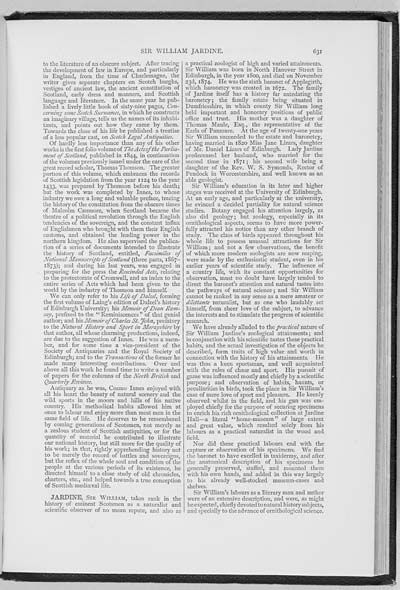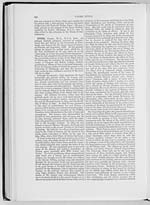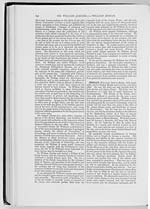Volume 3 > Half-Volume 6
(277) Page 631 - Jardine, Sir William
Download files
Individual page:
Thumbnail gallery: Grid view | List view

631 to the literature of an obscure subject. After tracing the development of law in Europe, and particularly in England, from the time of Charlemagne, the writer gives separate chapters on Scotch burghs, vestiges of ancient law, the ancient constitution of Scotland, early dress and manners, and Scottish language and literature. In the same year he pub- lished a lively little book of sixty-nine pages, Con- cerning some Scotch Surnames, in which he constructs an imaginary village, tells us the names of its inhabi- tants, and points out how they came by them. Towards the close of his life he published a treatise of a less popular cast, on Scotch Legal Antiquities. Of hardly less importance than any of his other works is the first folio volume of The Acts of the Parlia- ment of Scotland, published in 1844, in continuation of the volumes previously issued under the care of the great record scholar, Thomas Thomson. The greater portion of this volume, which embraces the records of Scottish legislation from the year 1124 to the year 1433, was prepared by Thomson before his death; but the work was completed by Innes, to whose industry we owe a long and valuable preface, tracing the history of the constitution from the obscure times of Malcolm Canmore, when Scotland became the theatre of a political revolution through the English tendencies of the sovereign, and the constant influx of Englishmen who brought with them their English customs, and obtained the leading power in the northern kingdom. He also supervised the publica- tion of a series of documents intended to illustrate the history of Scotland, entitled, Facsimiles of National Manuscripts of Scotland (three parts, 1867- 1873); and during his last years, was engaged in preparing for the press the Rescinded Acts, relating to the protectorate of Cromwell, and an index to the entire series of Acts which had been given to the world by the industry of Thomson and himself. We can only refer to his Life of Dalzel, forming the first volume of Laing's edition of Dalzel's history of Edinburgh University; his Memoir of Dean Ram- say, prefixed to the " Reminiscences" of that genial author; and his Memoir of Charles St. John, prefatory to the Natural History and Sport in Morayshire by that author, all whose charming productions, indeed, are due to the suggestion of Innes. He was a mem- ber, and for some time a vice-president of the Society of Antiquaries and the Royal Society of Edinburgh; and to the Transactions of the former he made many interesting contributions. Over and above all this work he found time to write a number of papers for the columns of the North British and Quarterly Reviews. Antiquary as he was, Cosmo Innes enjoyed with all his heart the beauty of natural scenery and the wild sports in the moors and hills of his native country. His methodical habits allowed him at once to labour and enjoy more than most men in the same field of life. He deserves to be remembered by coming generations of Scotsmen, not merely as a zealous student of Scottish antiquities, or for the quantity of material he contributed to illustrate our national history, but still more for the quality of his work; in that, rightly apprehending history not to be merely the record of battles and sovereigns, but the reflex of the whole soul and condition of the people at the various periods of its existence, he directed himself to a close study of old chronicles, charters, etc., and helped towards a true conception of Scottish mediaeval life. JAKDINE, SIR WILLIAM, takes rank in the history of eminent Scotsmen as a naturalist and scientific observer of no mean repute, and also as a practical zoologist of high and varied attainments. Sir William was born in North Hanover Street in Edinburgh, in the year 1800, and died on November 23d, 1874. He was the sixth baronet of Applegirth, which baronetcy was created in 1672. The family of Jardine itself has a history far antedating the baronetcy; the family estate being situated in Dumfriesshire, in which county Sir William long held important and honorary positions of public office and trust. His mother was a daughter of Thomas Maule, Esq., the representative of the Earls of Panmure. At the age of twenty-one years Sir William succeeded to the estate and baronetcy, having married in 1820 Miss Jane Lizars, daughter of Mr. Daniel Lizars of Edinburgh. Lady Jardine predeceased her husband, who married for the second time in 1871; his second wife being a daughter of the Rev. W. S. Symonds, Rector of Pendock in Worcestershire, and well known as an able geologist. Sir William's education in its later and higher stages was received at the University of Edinburgh. At an early age, and particularly at the university, he evinced a decided partiality for natural science studies. Botany engaged his attention largely, as also did geology; but zoology, especially in its ornithological aspects, seems to have more power- fully attracted his notice than any other branch of study. The class of birds appeared throughout his whole life to possess unusual attractions for Sir William; and not a few observations, the benefit of which more modern zoologists are now reaping, were made by the enthusiastic student, even in his earlier years of scientific study. The influence of a country life, with its constant opportunities for observation, must no doubt have largely tended to direct the baronet's attention and natural tastes into the pathways of natural science; and Sir William cannot be ranked in any sense as a mere amateur or dilettante naturalist, but as one who laudably set himself, from sheer love of the subject, to advance the interests and to stimulate the progress of scientific research. We have already alluded to the practical nature of Sir William Jardine's zoological attainments; and in conjunction with his scientific tastes these practical habits, and the actual investigation of the objects he described, form traits of high value and worth in connection with the history of his attainments. He was thus a keen sportsman, and well acquainted with the rules of chase and sport. His pursuit of game was influenced mostly and chiefly by a scientific purpose; and observation of habits, haunts, or peculiarities in birds, took the place in Sir William's case of mere love of sport and pleasure. He keenly observed whilst in the field, and his gun was em- ployed chiefly for the purpose of securing specimens to enrich his rich ornithological collection at Jardine Hall�a literal "home-museum" of large extent and great value, which resulted solely from his labours as a practical naturalist in the wood and field. Nor did these practical labours end with the capture or observation of his specimens. We find the baronet to have excelled in taxidermy, and after the anatomical description of his specimens he generally preserved, stuffed, and mounted them with his own hands, and added in this way largely to his already well-stocked museum-cases and shelves. Sir William's labours as a literary man and author were of an extensive description, and were, as might be expected, chiefly devoted to natural history subjects, and specially to the advance of ornithological science.
Set display mode to:
![]() Universal Viewer |
Universal Viewer | ![]() Mirador |
Large image | Transcription
Mirador |
Large image | Transcription
Images and transcriptions on this page, including medium image downloads, may be used under the Creative Commons Attribution 4.0 International Licence unless otherwise stated. ![]()
| Biographical dictionary of eminent Scotsmen > Volume 3 > Half-Volume 6 > (277) Page 631 - Jardine, Sir William |
|---|
| Description | Volume III. Contains names alphabetically from Macadam to Young. |
|---|

